We love essential oil foaming hand soap, but not the price! If you want to know how to make your own homemade moisturizing soap with essential oils, then grab yourself a foaming soap dispenser or container and follow this easy DIY recipe. You’ll save money, stretch your soap further, and use simple, safe ingredients like Dr Bronners liquid castile soap.
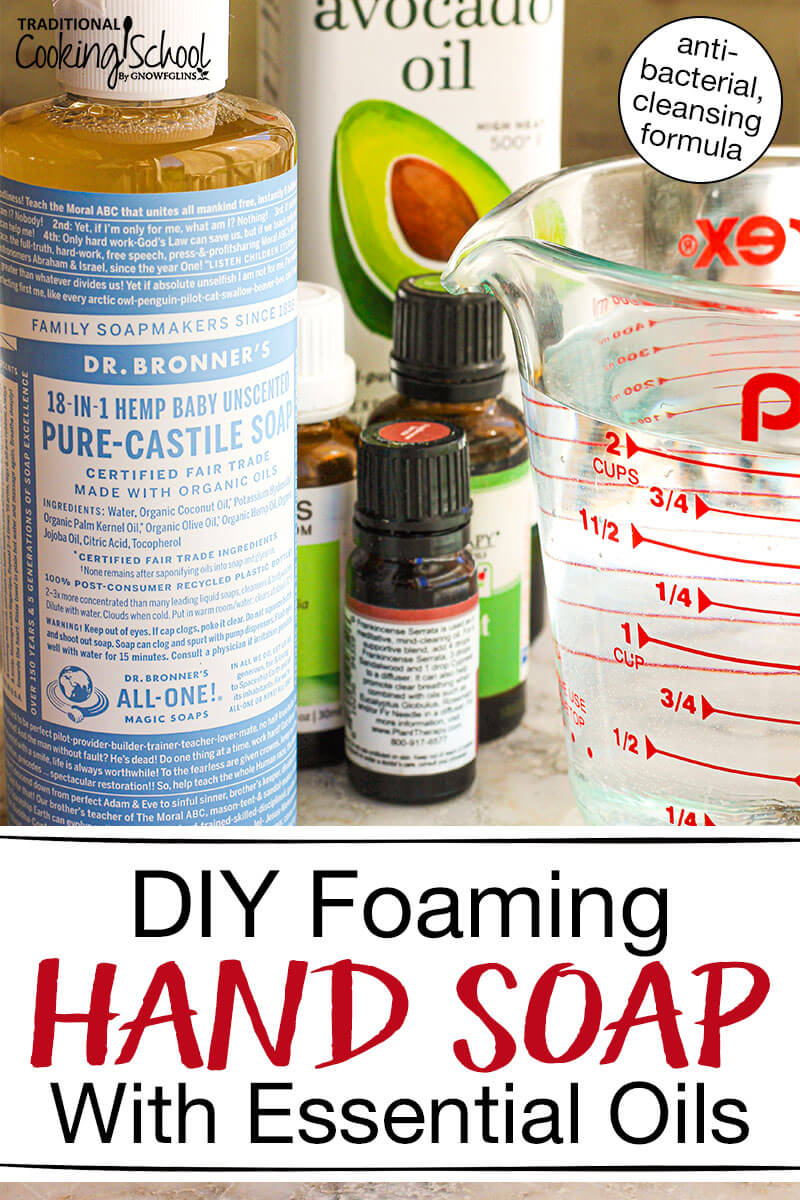
We love using essential oil foaming hand soap, but we do not love buying it or the refills.
Because… 1) the price! 2) the sometimes unnatural ingredients and 3) the single use plastic containers. (Making our own means we can re-use the bottle!)
So I figured out how to make my own.
Why are handmade soaps better?
Benefit #1 is that you’ll save money over buying them. The essential oil foaming hand soap refills are pricey!
However, you’ll not only save money over buying the refill soap mixture for your dispensers, but foaming hand soap in general is a great alternative to bar soap or pumps of straight soap.
Why? You only use a tiny bit of soap in a foaming hand soap dispenser (it’s mostly water inside), and this allows your liquid soap to go way, way, way, way further. Like 20x further, if I was to guess!
Secondly, when switching to a natural lifestyle, many of us transitioned away from antibacterial soaps — which have been linked to antibiotic resistance and altered hormones.
Only natural ingredients? Yes, please!
As mentioned above, the other reason I love handmade soap, over store-bought foam soaps, is I don’t like discarding the single use plastic containers.
So — homemade foaming soap is less expensive, completely natural, and a better use of our resources!
Is foaming hand soap easy to make?
Yes! Even the children can get involved. Such a simple recipe — only 4 ingredients — and a great task for them to do!
We have 3 dispensers — one at each sink — and refill them all at the same time.
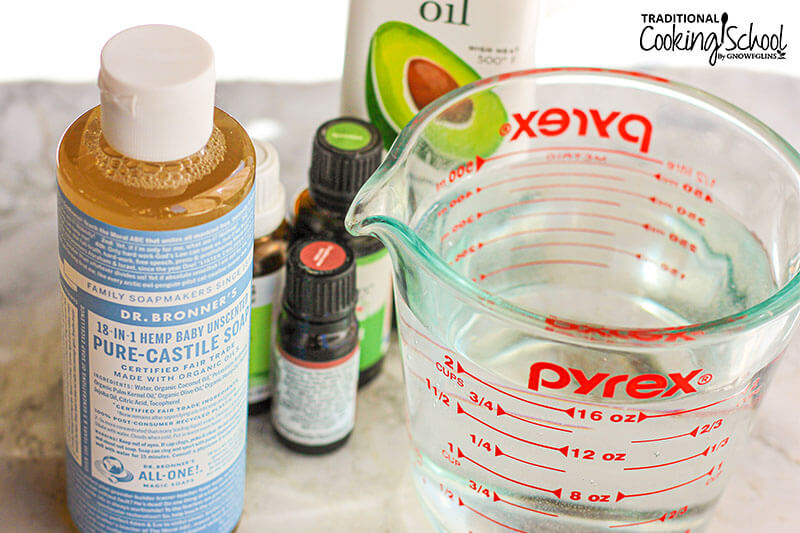
Ingredients For DIY Foaming Hand Soap
Surprisingly, your soap can be truly good for you. Let’s look at the 4 easy ingredients:
- Use a good base liquid soap (I use Dr. Bronner’s).
- Choose essential oils with antibacterial and cleansing properties. You may also choose essential oils for their aromatherapy benefits. Think: lovely floral scents, invigorating herbal smells and woodsy, calming fragrances.
- Moisturizing oil is needed to soften the skin because soap and water alone can be drying. Olive oil is the most convenient, but other skin-friendly options include argan, jojoba, almond, avocado, and grapeseed.
- Pure water!
Final tip: Be sure to leave a bit of room at the top for air! Without air, the pump can’t make foam and will just come out liquid. So be sure to leave a little room at the top.
That’s all! I keep my base soap under my kitchen sink. Then it’s easy to fill each bottle with water, base soap, a few drops of essential oil and a teeny bit of oil! Easy and fast.
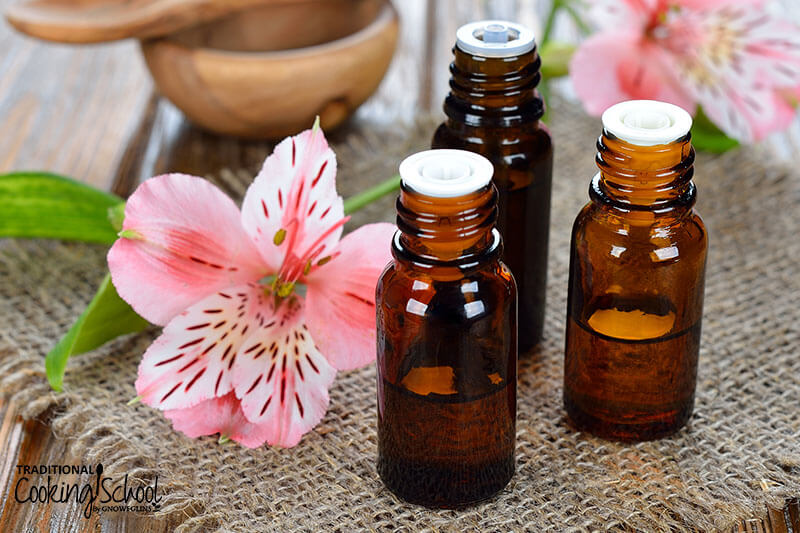
Best Essential Oils For Hand Soap
I use this immune boosting essential oil blend — which has a wonderful wintry smell. No worries about toxicity while boosting your immune system, and you can adjust to suit (less or more essential oil depending on preference).
Other popular single essential oils for hand soap include peppermint, lavender, ylang ylang, jasmine, rosemary, tea tree, and lemongrass.
Best Foaming Soap Dispenser
Need a foaming pump dispenser? Here’s a glass option for you — or you can repurpose a cheap one.
If you don’t have one already, you could buy a cheapo just to empty it out and fill it with good stuff.
And now for the recipe…
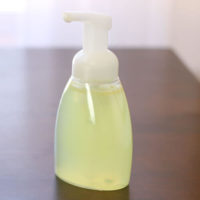
Homemade Essential Oil Foaming Hand Soap
We love using essential oil infused foaming hand soap, but we do not love the price on the refills. 😉 So I figured out how to make our own refills. Use whatever essential oil you prefer; I'm using this immune boosting blend. This is a great task to get the children involved in, plus you can stretch your soap A LOT farther because you need so little soap in a refill -- it's mostly water!
Ingredients
- pure water preferably soft
- 2 tablespoons liquid castile soap such as Dr. Bronner's
- 1/2 to 1 teaspoon liquid oil such as olive, almond, avocado, or grapeseed
- 10 to 15 drops anti-bacterial essential oil such as lavender, peppermint or blend
Instructions
-
Add water to fill within 1" of the top of the dispenser. You need enough room for the other ingredients and to put the pump lid back on.
-
Add liquid soap, oil, and essential oils.
-
Replace pump lid.
-
Dispense soap as needed. Use and enjoy!
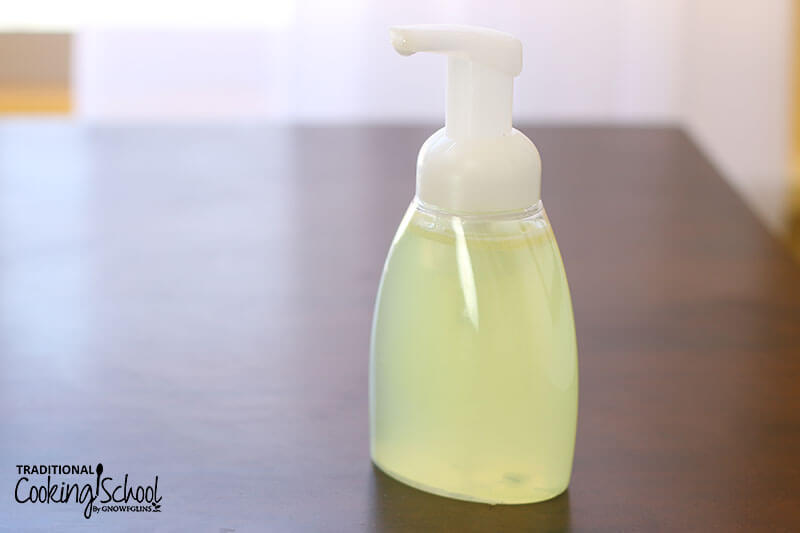
Other household DIY recipes:
- Homemade Non-Toxic All-Purpose Cleaning Spray With Essential Oils #AskWardee 061
- Homemade Essential Oil Air Freshener #AskWardee 075
- Instant Pot Hard Lotion Bars
- DIY Essential Oil Chest Rub Decongestant (for adults, kids, & babies!)
- Homemade Essential Oil Roll-On Headache Stick {print & video instructions}
Looking for other great essential oil posts? Enjoy these!
- How to Organize and Store Essential Oils
- Is It Safe To Ingest Essential Oils? {medicinal & culinary use}
- Top 5 Essential Oils For Nourished Skin
- Top 5 Budget-Friendly Essential Oils For Natural Seasonal Allergy Relief
- Top 5 Essential Oils For Adrenal Support
- Top 5 Essential Oils For Women
- Top 5 Essential Oils For Men
- Top 5 Essential Oils For Gut Health
Do you make your own DIY foaming hand soap refills? What are your favorite essential oils to add?
This post was originally published and written by Wardee Harmon on 6/22/16. It was updated and republished on 4/3/20.
We only recommend products and services we wholeheartedly endorse. This post may contain special links through which we earn a small commission if you make a purchase (though your price is the same).


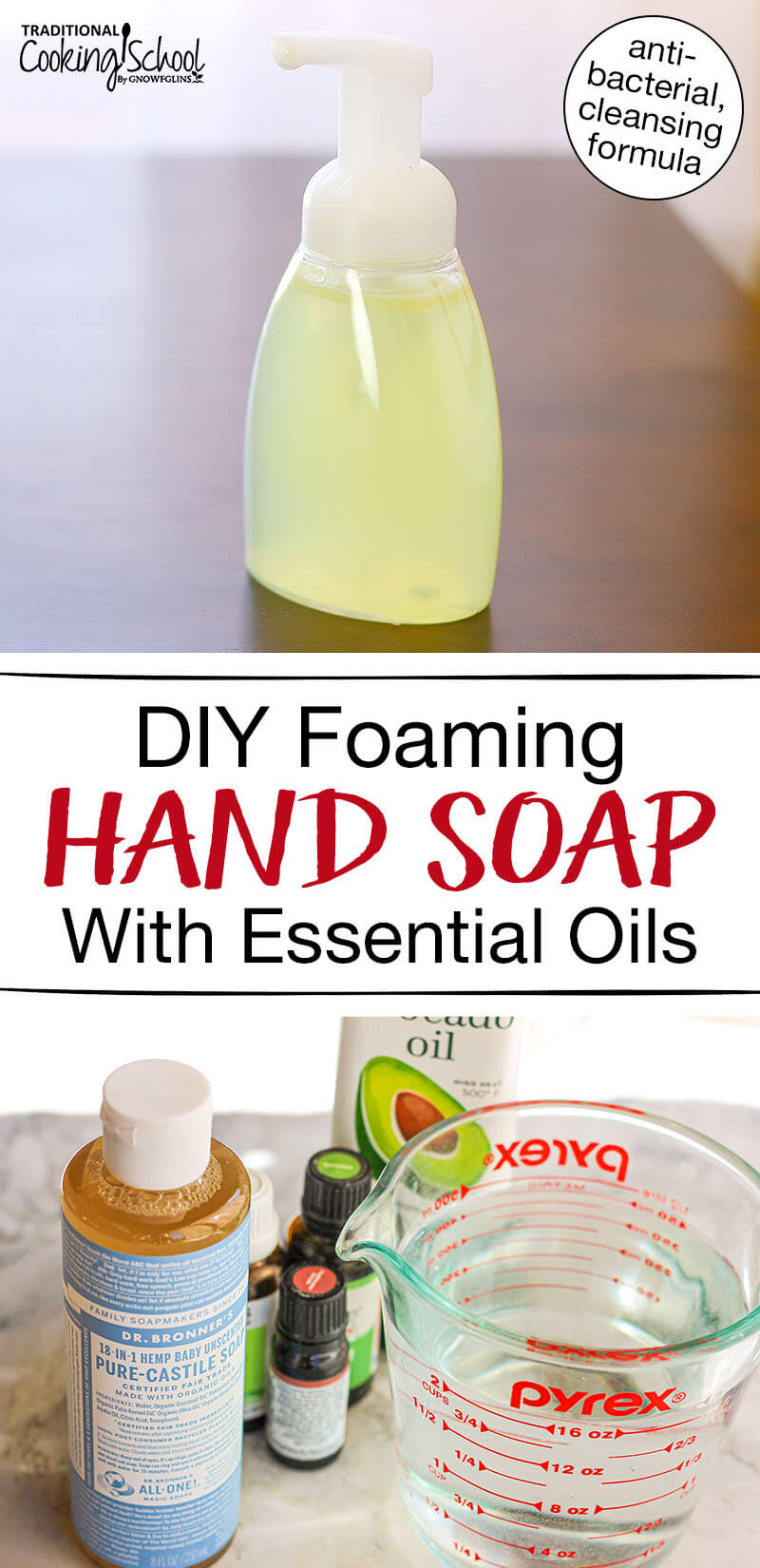
I did this for awhile, but my pumps seemed to break a lot… Maybe I’ll try it again. Can you tell me why add the oil? Also, a tip to share: add a handful of decorative glass beads/ rocks (like from craft store) to the bottom of the bottle to weigh it down and to help mix ingredients when shaken!
Molly ~ Great idea to add the beads! The oil keeps the pump lubricated, so it doesn’t break. 🙂
I was wondering about the oil, too. I’ve been making my own but I’ve never heard of adding that. Thanks for clarifying. I’ll start adding a bit of oil.
I’ve been using a very similar recipe for years in our soap pump. We absolutely love using it because the oil we use (coconut), also helps to moisturize and keep hands soft. Although I love peppermint, my family prefers citrus and lavender oils. You may just have to experiment with different pumps & see which works best for you. 🙂 I would definitely recommend this recipe to anyone. The best part is that it’s non-toxic, and doesn’t smell fake 🙂
Try sweet orange and peppermint in equal amounts. It’s lovely.
Was this recipe for 8oz pump? Mine didn’t Lather to well
Hi Paula,
What soap did you use? Did you vary the recipe at all? It does usually foam very well. We’re not sure on the size of the pump, but 8 ounces sounds close.
Millie
Traditional Cooking School
Excellent idea on a little something to help mix it when shaken. It looks like a great way to use up some not so fresh olive oils I have here.
My only problem with this is that you have to shake it before each use. That is a little hard with my young grand babies…any suggestions?
Hi Brenda,
We don’t shake with each use either. It should still be fine. 🙂
Millie
Traditional Cooking School
Love your recipe! Now I can make my own foaming hand soaps.
Wardee, you do such a great service on so many levels.
Thank you!
Love your recipe! Now I can make my own foaming hand soaps.
Wardee, you do such a great service on so many levels.
Thank you!
Can you use rosemary essential oil?
Hi Tara,
You should look it up and see if there are any reasons rosemary shouldn’t be used this way and this frequently. Wardee could look it up, but you’ll still need to know for yourself based on how you intend to use the soap. 🙂
Millie
Traditional Cooking School
The only reason not to use rosemary oil would be if someone in your household has MS (muscular sclerosis). Rosemary oil can trigger a relapse in this condition .
Hi Christine,
We are not in a position to give medical advice but we cannot find any research to corroborate a link between rosemary essential oil and MS.
~Danielle, TCS Customer Success Team
Hi wardee, Thank you for sharing this recipe with us. I too had a hard time with the price of replacing foaming soap. I had Bronners castile soap with eucalyptus on hand, added a few complimentary drops of basil essential oil, olive oil and water and what a pleasant fragrance, nice foaming soap that feels silky smooth to my hands and skin. Adding olive oil made all the difference. Enjoying what I’m learning thru you and your school.
I’ve been using a similar recipe for a while now. I love it! However, I’ve noticed that my sinks are starting to drain slowly. I’m wondering if it’s build up from the oil. (We use coconut.) Anyone else have any issues with this?
Hi Courtney,
Wardee hasn’t had an issue — not any more than with using more natural soaps in general.
She does regularly use baking soda/vinegar to clean drains, though.
Millie
Traditional Cooking School
HI Courtney,
You said sinks (plural). Is that bathroom or kitchen or both.There are many reason why drain can drain slowly. One, is that if you wash your hair in the sink,(or shower) the hair is clogging things up; or if you use cloth wash cloths the fabric will go down the drain. If grease goes down the pipe, that can cause problems. There could be roots growing in the line or the line is collapsing. You can get a wire mesh strainer basket to fit the drain hole (of sinks and showers) that catches debris and it won’t go down the drain; then just lift the strainer out, put a cloth over your finger and swirl it in the drain basket; remove the debris and throw the debris in the wastebasket and return the strainer basket to the sink. A man at a plumbing store told me years ago, DO NOT use LIQUID PLUMBER or DRAINO, or any other commercial draining product. Instead he said at least once a month put a kettle on the stove that has 2 or more gallons of water in it, and bring it to a fast boil. Then pour the hot water down the sink. The hot water removes debris and takes it to the sewer line. By doing this you will rarely have a draining problem. Kitchen sinks have “baskets” in them; but use the mesh strainer. When you need to hold water in the sink, then remove the mesh strainer, and put the baskets back in. When it is time to release the water, have your mesh strainer in one hand, remove the basket, and get the mesh strainer back in as quick as possible. If the water stops draining (or gets to slow) put the cloth around the finger, and leave the mesh strainer in place, and run your finger around a little bit to get debris and open up a hole to restore draining. (I do this after showering and have a water back up; {but the wife and stepson have not figured out how to do that yet, they want quick drain, so take the mesh strainer out}.)
Hi, would washing dishes with this soap be a good idea???
Hi Kitt,
We don’t think so. It is too diluted and also not a great soap for washing dishes (it doesn’t cut grease like a dish soap). Sorry!
Millie
Traditional Cooking School
Could I use this soap for instance for washing hands after handling raw chicken? are there enough anti bacterial properties in it? Thanks. Gwenny
Hi Gwenny,
We do! Hot water and a good scrubbing makes us feel perfectly fine with using this for all hand washing. 🙂
Millie
Traditional Cooking School
Does the end result leave a dry soap feeling? I have tried similar recipes – not using foaming dispenser – and not matter which our how much oil I added, I’d still get that dry soapy feeling that you get with pretty much any soap. (I’ve never tried Dr. Bronners due to price, but make my own liquid soap by adding shaved bars of Kirks Castile soap to hot water).
Any suggestions?
Dr Bronners is worth it if you dilute it. A lot of stores carry the small travel size for a cheaper price so you could still get a good amount of use for your money. Is it a dry soapy feeling or are you new to natural soaps? I only ask because that dry sticky feeling is what normally gets people at first, especially after a shower. It’s actual clean skin, not coated with a chemically based “moisturizer” like you find in your dove or other bath products. If that’s not the case then maybe the boil down method is the problem? I haven’t had much success with that method myself.
That’s right. It’s a dry, tight feeling. I am not new to natural soaps, though. I feel that all the natural soaps I purchase leave this feeling, but I don’t know why. I guess I know now. Thanks.
By the way, I was looking at Dr. Bronners on Amazon just a few days ago. As I read the ingredients, I noticed that there is no soap in it! Just a bunch of oils and two ingredients that i did not recognize, but I don’t believe that they are soaps.
The ingredients in Dr Bronner’s soap are soap ingredients. Look again, you’ll notice potassium hydroxide, also known as potash. This is what saponifies the oils, or turns them into soap. Don’t worry, it’s the real deal.
HI Tiffany,
This isn’t something that Wardee experiences. This is perhaps related to water hardness or softness? We can’t suggest anything, sorry.
Millie
Traditional Cooking School Support
This post is great! I was made and currently using a chamomile foaming soap but am excited to try this one, after finish my last soap. Thanks so much 🙂
It stained my marble sinks under both dispensers! Have tried everything….yellowish stain where bottles were. Having hard time getting them out
I have not tried this soap recipe but I had the same thing happen to my bathroom granite. I noticed that there moisture under my soap dispenser and it had discolored the granite. I dried the spot off and left it for a few days. The spot finally started to lighten up. I now keep a glass coaster under my soap dispensers to keep this from happening again.
Hi Wardee,
You didn’t mention what size container you are using or how many ounces of water you are using. I have seen recipes that use 2 to 1; some use 4 to 1 (4 parts water to 1 part castile soap). I would find it useful to know how many ounces of water you are putting into the container so I can determine the ratio. For instance if you are using 7 ounces of water and 2 Tablespoons of Castile Soap (1 ounce). That says the total mix is 8 ounces which means the ratio is 7 to 1. But if the ounces of water is more than 7 then the ratio needs to be revised. If I have a container that has 32 ounces of water, I know I would have to use more than 2 Tablespoons, otherwise the mix is going to be to weak. You are using a vague measurement of 1 inch from the top, and then use 2 Tablespoons of castile soap. 2 Tablespoons is an exact measurement as it is based on the ounce size of your specific container. So it is better to know how many ounces the container holds, how many ounces of water to use because we know we use 2 Tablespoons of castile soap. Once I know the specific ounce of water (and the size of the container), I can adjust everything according to what size I am making. So I need to know what size dispenser you are using and how many ounces of water you are using. Are you able to get that information? The comments I read are all favorable. It sounds like a good one, I just need the missing information I listed above.
Hi, Jerry,
Wardee uses an 8 oz container. 🙂
~Peggy, TCS Custome Success Team
and how many ounces of water (she is using 1 ounce of castille soap)
Hi, Jerry.
You can easily scale this recipe up by multiplying all of the other ingredients by 4 and then adding enough water to fill your container.
Sonya
TCS Customer Success Team
I usually add about 1 teasp vegetable glycerin to my foamer recipe for app 6 oz formula, instead of olive or coconut oils. Is there any reason not to do this?
Hi, Gigi:
I don’t think there’s any reason not to use the vegetable glycerin. It’s probably a matter of personal preference — and the fact that most of us have olive oil or coconut oil handy in our kitchens, whereas we might not happen to have vegetable glycerin. 🙂
Sonya
TCS Customer Success Team
I’m late to this post, but I just had to chime in to show my appreciation for the share. I do make the foaming soap with Castile. I don’t know why it never occurred to me to add essential oils. Boy do I feel silly! So, thanks for sharing! I will add that making this with the sweet almond Castile soap smells like Jergens. That takes me back to some fond childhood memories of being forced to wash my hands before meals. LOL!
I added a small amount oil and vegetable glycerin to the mix but it is separating to the top. Is this normal?
Hi, Lisa,
I would just give it a good shake to mix the oil back in. 🙂
~Peggy, TCS Customer Success Team
I almost killed one of my cats adding Tea Tree to my foaming soaps. Researching I have learned it is one of the most toxic essential oils for cats. It would help so much for those of us with animals if disclaimers were added to all essential oil posts. Not asking for anyone to assume responsibility say what is or what is not safe…just advise when it is a know poison. Thank you for any help in making this happen.
Mimi, it doesn’t matter what any essential oil recipe is used, we all need to become more proactive in looking up the contraindication for each oil used in a recipe.
Hi, do you feel comfortable using the immune strength essential oil in the pump soap if kids will be using it? I use immune strength on myself but won’t diffuse it in my home because Rocky mountain suggests not using it on children under 10. I have a 6 year old son & really want to switch to a handmade soap. Thank you for sharing your knowledge.
Hi Claudine,
Caution should be utilized when using essential oils on or around children. You could use a kid safe essential oil in your hand soap. Lavender is kid safe but peppermint is not intended for children under 10.
You should double check the dilution rate for kid safe essential oils and reduce the amount of essential oil added to your hand soap if necessary.
~ Vicki, TCS Customer Success Team
Yeah… its indeed a really good guide… it turns out to be useful in today’s condition 🙂
I have done this for years and we love it as well. I have never measured anything however. Keep it easy and use a good squirt of soap, a much smaller squirt of oil,( I use food grade glycerin… never have dry skin!) add your essential oils, and top up with water. You can’t really go wrong on the amounts. If you don’t like how it acts, just adjust next time:)
Does it matter what pump dispenser you use? I feel like some work better than others!
Hi, Ken.
We don’t have a recommendation as we’ve used recycled ones and haven’t purchased any new. 🙂
~Danielle, TCS Customer Success Team
I have been researching this topic and have seen that a preservative is recommenced for foaming hand soap not expected to be used within two weeks. Can you advise on this and recommend the best preservative?
Thank you!
Thanks for writing up this environmentally-friendly DIY! I tried it and it works just like any other soap! I reused a Method and Bath & Body Works foaming dispenser and removed the label for minimal design. I added May Chang/Blood Orange EO for one bottle in the kitchen, and Lavender/White Sage EO for the bathroom. ?
I just moved to a house that has a septic tank, is this hand soap safe for a septic tank? The oil is what I am concerned about. Thank you! 🙂